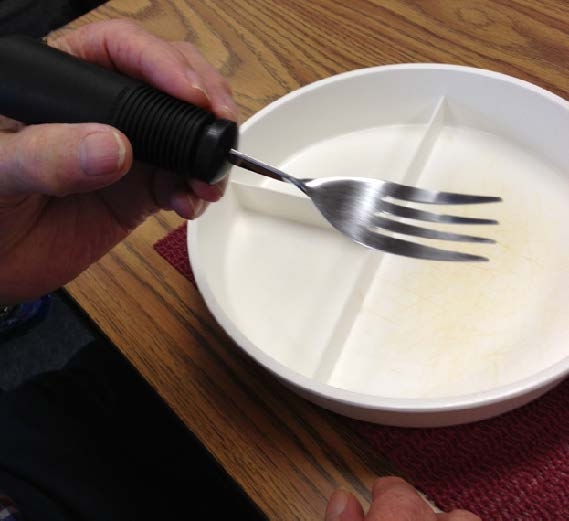Best Practices in Intergenerational Programming: Practice 10
ID
FCS-43P (FCS-163P)

Adaptive Equipment Is Used as Appropriate.
Practice 10 • Adaptive Equipment
Intergenerational programs are most effective when adaptive equipment is used as appropriate.
There is a chance that clients in an intergenerational program will need adaptive equipment. The primary reason to consider adaptive equipment is to remove barriers to participation. Examples of adaptive equipment include pencil holders for slip resistance, magnifying glasses or digital projectors for better viewing, and chair supports or lifts for improved positioning. This equipment is often essential to engagement in the activity and with an intergenerational partner.

Application of the Practice
As a teacher or care provider, question what may help remove a barrier or enhance a learning situation. Sometimes creative solutions for adaptations involve Velcro, pillows, longer handles, or pulleys. Organizations are available to consult on particular needs, such as the Training and Technical Assistance Center (T/TAC; www.ttac.vt.edu) for students in Virginia; and online retailers and DIY sites, such as www.enablemart.com, www.seniorssuperstores.com, and www.pinterest.com/otconsulting/diy-adapt/, offer resources.

Program Ideas
The lack of fit between a person and his or her environment is a primary reason people do not choose to participate in activities. Adaptive equipment is not always needed for activities involving children and elders, but it can ensure that all who want to join can be active and successful.
The right tools can help.
- Look at a need for adaptations any place there is a barrier, including height, size, and location of furniture and materials.
- Equipment can be purchased or adapted in a DIY fashion.
- Tools may be simple (such as large-handled spoons) or sophisticated (such as digital communicators for a child who lacks speech).
- Spring-action scissors, wide paintbrushes, and anchors for papers can make a world of difference during art and writing activities.
- A wide array of cooking tools can be provided for programming that appeals to all age groups.
- Ergonomic gardening tools and modified containers, such as raised beds or wheeled containers, can accommodate gardeners of all abilities.
- Communication tools can help enhance relationships. Devices and apps are becoming more common for adults who are losing their speaking ability due to debilitating conditions. For example, Boardmaker Software (www.mayer-johnson.com/boardmaker-software/) is a communications tool with more than 3,000 pictures.
Best Practices for Intergenerational Programming
- Staff members of the adult and child programs collaborate to plan activities.
- Participants are involved in decision-making about the activity and during activities.
- Participation is voluntary.
- Participants are prepared ahead of time and reflect on the activity afterward.
- Activities reflect interests, backgrounds, and social histories of program participants.
- Activities are age- and role-appropriate.
- Activities support interaction among intergenerational participants.
- Facilitators skillfully stage the environment to promote interaction.
- Facilitators consider the social environment and the role of staff members.
- Adaptive equipment is used as appropriate.
- Facilitators document and communicate experiences to build on in future activities.
Additional Resource
Rosenberg, L., A. Kottorp, and L. Nygard. 2011. “Readiness for Technology Use With People With Dementia: The Perspectives of Significant Others.” Journal of Applied Gerontology 31 (4): 510-530. http://jag.sagepub.com/content/31/4/510.
Wistrom, E. 2012. “Information About Adaptive Equipment.” Bright Hub Education website. www.brighthubeducation.com/special-ed-physical-disabilities/61925-examples-of-adaptive-equipment-for-students/.
Reference
Jarrott, S. E. 2011. “Where Have We Been and Where Are We Going? Content Analysis of Evaluation Research of Intergenerational Programs.” Journal of Intergenerational Relationships 9:37-52. doi:10.1080/15350770.2011.544594.
Project TRIP
A Children’s, Youth, and Families at Risk project of Virginia Tech.
Shannon Jarrott, Professor, Social Work, The Ohio State University
Karen DeBord, (retired) Extension Specialist, Virginia Tech
Contact: Crystal Tyler-Mackey, Extension Specialist and Leader, Community Viability, Virginia Tech, cmtyler@vt.edu.
Intergenerational programs are those that connect younger and older generations to foster positive experiences. Research continues to grow, noting that when successfully delivered, intergenerational programs result in positive health effects, child learning, and appropriate socialization for both young and old (Jarrott 2011). For more information on IG practice, visit https://u.osu.edu/bridge2health/.
The 10th practice relates to adaptive equipment.
Disclaimer
Commercial products are named in this publication for informational purposes only. Virginia Cooperative Extension does not endorse these products and does not intend discrimination against other products that may also be suitable.
Virginia Cooperative Extension materials are available for public use, reprint, or citation without further permission, provided the use includes credit to the author and to Virginia Cooperative Extension, Virginia Tech, and Virginia State University.
Virginia Cooperative Extension is a partnership of Virginia Tech, Virginia State University, the U.S. Department of Agriculture (USDA), and local governments, and is an equal opportunity employer. For the full non-discrimination statement, please visit ext.vt.edu/accessibility.
Publication Date
October 24, 2025



